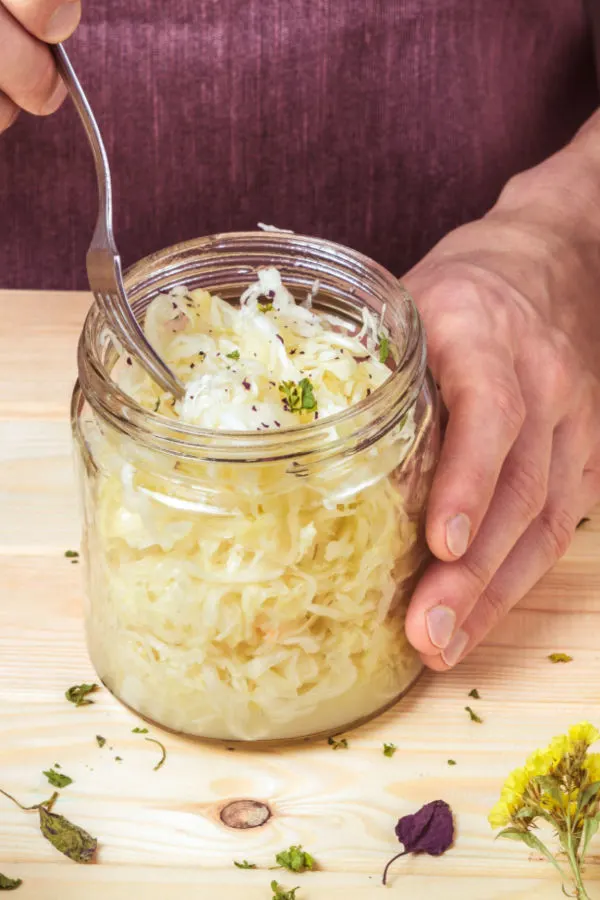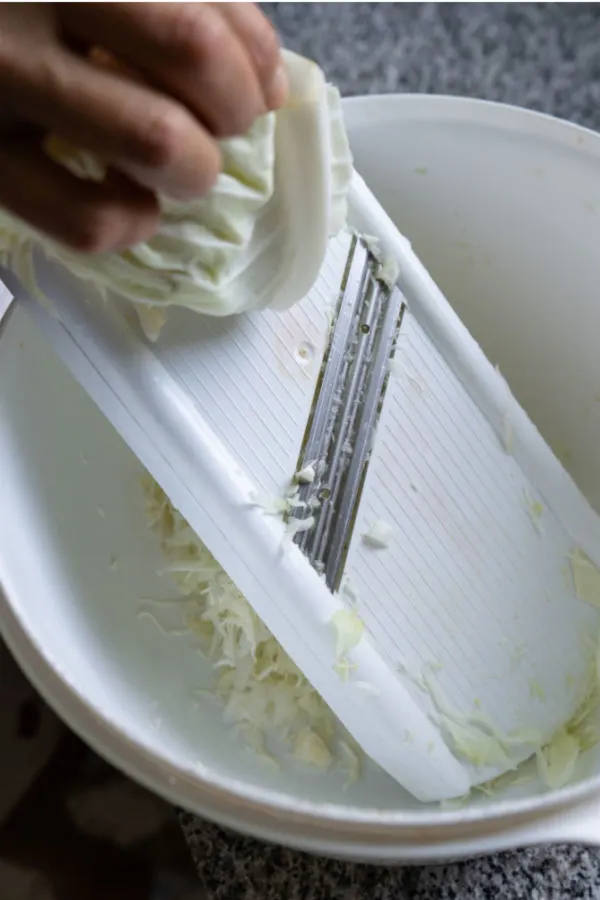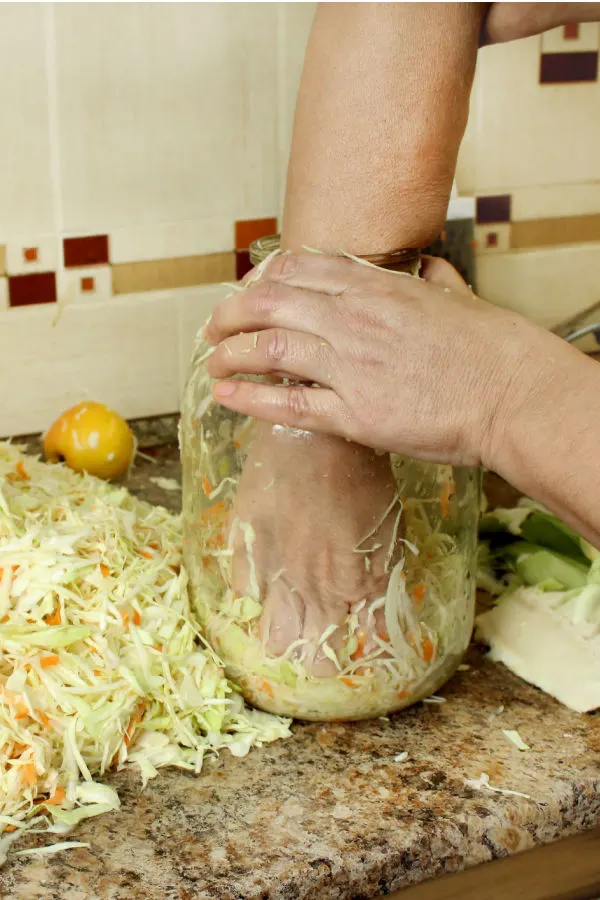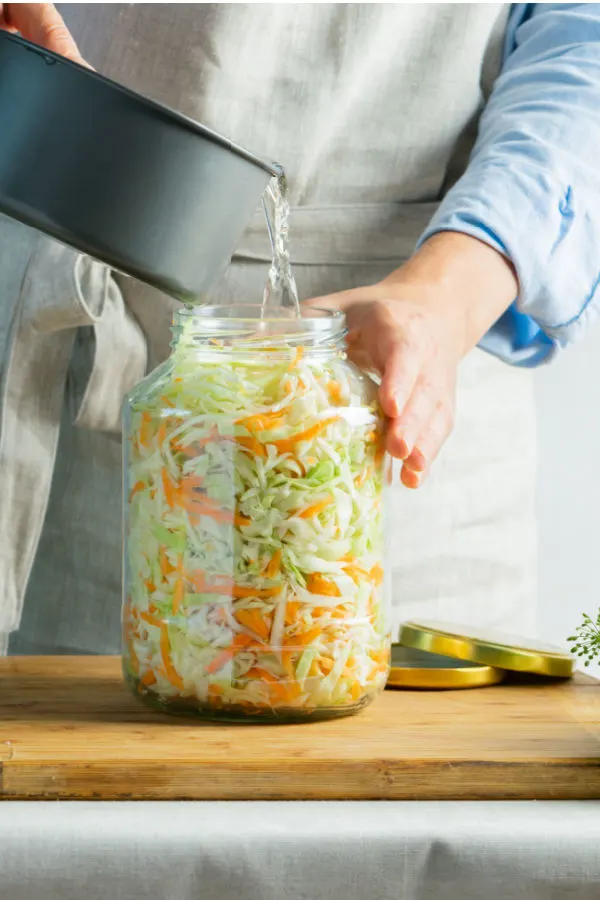Making your own sauerkraut may seem like a complicated process, however it is actually quite easy to do. Every summer we harvest heads of cabbage from our garden and make our own sauerkraut for use throughout the year.
After all, there is only so much coleslaw, cabbage rolls and fried cabbage that one can eat before the fresh heads of cabbage go bad. So instead of getting tired of eating cabbage in the middle of summer, preserve it instead.
Although there are several methods that you can use to make sauerkraut, today we will share with you how we make it using the fermentation process. This process is the easiest method and only requires just a few items.
Equipment Required For Homemade Sauerkraut
1. Fermenting Container
The preferred container is a stoneware crock. However, food grade plastic or glass containers can also be used successfully.
Although for most beginners large Mason jars are a popular choice because of their multi-use capabilities.
2. Weight
It is vitally important that the shredded cabbage and other vegetables remain submerged in liquid during the fermenting process. In order to ensure this happens you will need something to sit on top of the veggies to hold them down.
This can be accomplished in a number of different ways. You can use a plastic bag filled with water, a smaller sized glass jar filled with water, fermenting weights made especially for use with mason jars, a heavy plate, or crock weights.
3. A Cover
Finally, you will need a way to cover the container, however, you don’t want a cover that provides an airtight seal. This is because during the fermentation process the sugars turn into lactic acid and carbon dioxide and produce gas bubbles.
Therefore, those gases need a way to escape. Once again, as with your container and weight, this can be done with items you already have on hand or by purchasing more specialized equipment to make it a fool-proof process.
You can use something as simple as a clean tea towel to cover your container. Or you can use a loose fitting lid and “burp” it once a day.
However if you plan on fermenting cabbage or cucumbers to make pickles, you may want to consider purchasing an air-lock lid for your Mason jars or a fermentation crock with a water seal. The lid has a trough of water around the top of the pot, which allows gases to escape without letting oxygen inside the crock.
I purchased A Fermenting Crock, Weight & Lid from Lehman’s only to find out that it is made right here in Ohio!
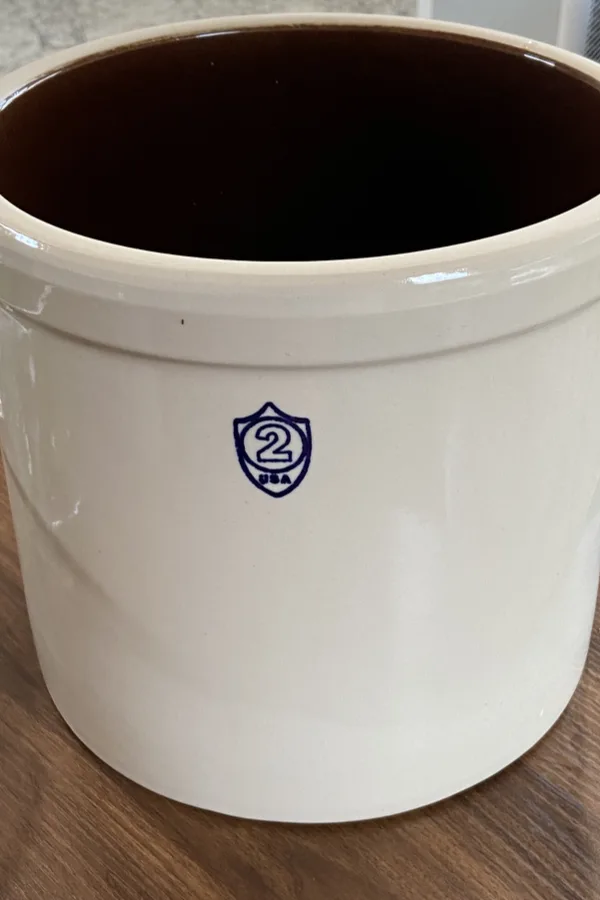
Easy Homemade Sauerkraut Recipe
*Complete recipe instructions including specific measurements, cook temperatures and times are located in a printable recipe card at the bottom of this article. However, be sure to keep reading for helpful tips and tricks when making this recipe.
Ingredients
- 1 3/4 pounds shredded red or green cabbage (about 1 small head). Reserve one of the large outer leaves to use later.
- 2 medium carrots, peeled and shredded (optional)
- 1 clove garlic, finely minced (optional)
- 1 tablespoon sea salt (heaping if using the carrots and garlic)
- 1 teaspoon caraway seed (optional)
More Info About The Ingredients:
Be sure to use the freshest cabbage available to you. Although you can use any color cabbage you like, the fresher it is, the more crisp the finished product will be.
The role the salt plays in the fermentation process is a vital one. Therefore it is best to use an unrefined salt that is full of natural vitamins and minerals.
Unrefined sea salt is ideal to use when fermenting. However you could also use Picking salt and Kosher salt, as long as an anti-caking agent hasn’t been added to mixture.
It is not recommended to use iodized salt for making sauerkraut. Iodine tends to inhibit the beneficial bacteria in the fermentation process and cause harmless discoloration to vegetables.
Instructions
Before making your sauerkraut mixture, be sure to start with a clean space and clean equipment. You don’t want to risk small bacteria spores spoiling the cabbage.
Begin to prepare the cabbage by removing the outer leaves of your cabbage and discard, reserving one undamaged outer leaf for later use. Then cut the head into quarters, removing the core as you go.
Rinse the cabbage well, allowing the water to flow between the leaves. Then be sure to let it drain well.
Thinly shred the cabbage with a knife, food processor, or mandoline slicer. Place the shredded cabbage in a large bowl.
Now it is time to prepare the other vegetables. Start by washing and peeling your carrots. Then peel the garlic.
Next shred your carrots and add it to the cabbage mixture. Then mince the garlic and add it to the bowl.
Add the remaining ingredients and toss well. Let the mixture sit 15 minutes. After 15 minutes massage the mixture with your hands until a good amount of liquid has been released.
How To Ferment Sauerkraut
Now, one handful at a time, pack the sauerkraut mixture into your fermenting container and tamp it down tightly. Continue doing this until your container is about 3/4 full. *Do not fill it all the way to the top.
Pour the remaining brine into your fermenting container. The liquid should be completely covering the vegetables.
If there is not quite enough liquid to cover you can mix extra brine using the ratio of 1 teaspoon of sea salt to 1 cup of water. However it is best to use bottled or filtered water because tap water often contains chemicals that can kill both good and bad bacteria.
Now grab that reserved cabbage leaf and cover the top of your mixture before adding the weight. This is a great trick to help keep small, loose pieces of cabbage from floating to the top.
Finally, place the weight on top and cover the jar using one of the methods described above. There may be some overflow, so it is a good idea to place your container in a rimmed pan or something to catch any liquid that might drip out.
Amount Of Time Required To Ferment
Now comes the hard part, the waiting! Leave the container at room temperature and out of direct sunlight for 4-30 days.
The number of days that you will let it ferment is completely up to your individual taste. Start tasting on day 4 or 5 and taste every day or two until the texture and tang are to your taste preference.
Once you are satisfied with the flavor remove the weight. Then transfer the sauerkraut and liquid to containers with lids to store in the refrigerator for up to six months.
Once put in the refrigerator the fermenting process will be nearly halted and your sauerkraut is ready to eat.
How To Can Sauerkraut
If you prefer to make the sauerkraut shelf stable you can do so by canning. While it is true that the live cultures will be killed during the canning process, the sauerkraut still has many benefits and can be stored safely for a much longer period of time.
Sauerkraut can easily be canned in a hot water bath using either a raw pack or a hot pack method once the fermentation process is complete.
Raw Pack Method
Fill sterilized jars with sauerkraut, leaving 1/2 headspace at the top of each jar. Then cover the contents of the jar with brine from the fermentation container. Use a plastic utensil down the sides of the jar to remove any air bubbles. Wipe the rims clean.
Place the lid on the jars and finger tighten the bands. Place the jars in a water bath canner with room temperature water at least 1 inch above the top of the jars. Bring the water to a boil and once it comes to a rapid boil set the timer for 20 minutes for pints or 25 minutes for quarts (adjusting for altitude as necessary).
Hot Pack Method
Slowly warm your sauerkraut and brine in a heavy-bottomed pot, stirring frequently until the contents come to a boil.
Fill sterilized and pre-warmed jars with the sauerkraut and top off with brine, leaving 1/2 inch headspace. Remove the air bubbles, wipe the rim clean, and add the lids and bands. Carefully lower the jars using a jar lifter in a hot water bath that is already boiling.
Again, be sure that there is at least 1 inch or more of water above the top of the jars. Process for 10 minutes for pints and 15 minutes for quarts (adjusting for altitude as necessary).
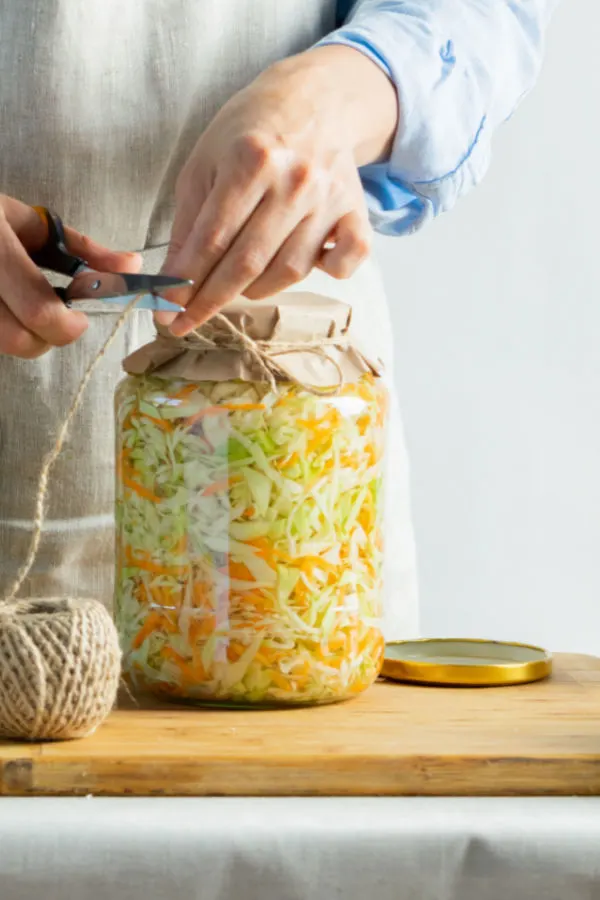
Once the jars have been processed for the required time, turn off the heat and let the jars sit for 10 minutes in the water.
Then carefully remove the jars and place them on a thick towel to cool for 24 hours. Check the jars to make sure that they sealed properly and store at room temperature.
Enjoy!
Mary and Jim

Jim and Mary Competti have been writing gardening, DIY and recipe articles and books for over 15 years from their 46 acre Ohio farm. The two are frequent speakers on all things gardening and love to travel in their spare time.
As always, feel free to email us at thefarm@owgarden.com with comments, questions, or to simply say hello! You can sign up for our free email list in the subscribe now box in the middle of this article. Follow us on Facebook here : OWG Facebook. This article may contain affiliate links.
Easy Homemade Sauerkraut
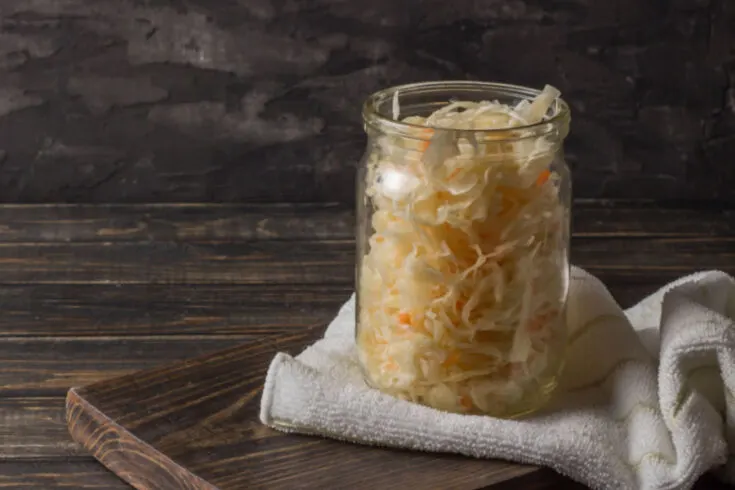
How to ferment cabbage to make sauerkraut at home. A healthy and inexpensive way to preserve cabbage and improve your gut flora. This recipe makes approximately 1 quart.
Ingredients
- 1 3/4 pounds shredded red or green cabbage (about 1 small head). Reserve one of the large outer leaves to use later.
- 2 medium carrots, peeled and shredded (optional)
- 1 clove garlic, finely minced (optional)
- 1 tablespoon sea salt (heaping if using carrots and garlic)
- 1 teaspoon caraway seeds (optional)
Instructions
- In a large bowl, combine the cabbage, carrots, garlic, salt, and caraway seeds.
- Massage the vegetables with clean hands until the natural juices are released (approximately 2-15 minutes)
- One handful at a time, pack your sauerkraut mixture into your choice of container using your fist to tamp it down tightly. Keep doing this until your container is about 3/4 full. You will need space for the weight(s) at the top.
- Use the liquid in the bowl that the cabbage was in and pour it over top of the cabbage. The liquid should be completely covering the vegetables.
- Use the large cabbage leaf to cover the top of the small shredded cabbage in the crock. Now put weight(s) on top of the large cabbage leaf to make sure the vegetables remain submerged in the liquid. *There are a variety of things you can use as weights (see post for details).
- Loosely cover the jar, being sure that the lid does not create an air tight seal.
- Leave to ferment at room temperature and out of direct sunlight for 4-30 days. Start tasting on day four and taste every day or two until the texture and tang you prefer is achieved.
- When you are satisfied with the taste place the sauerkraut in the refrigerator, still in the liquid, covered. Store for up to six months.
Notes
*Canning instructions included in the article.
Recipe courtesy of Old World Garden Farms
Nutrition Information:
Yield:
16Serving Size:
1Amount Per Serving: Calories: 9Total Fat: 0gSaturated Fat: 0gTrans Fat: 0gUnsaturated Fat: 0gCholesterol: 0mgSodium: 402mgCarbohydrates: 2gFiber: 1gSugar: 1gProtein: 0g
Nutritional Information is to be used as a general guideline only . Nutritional calculations will vary from the types and brands of the products used.

